
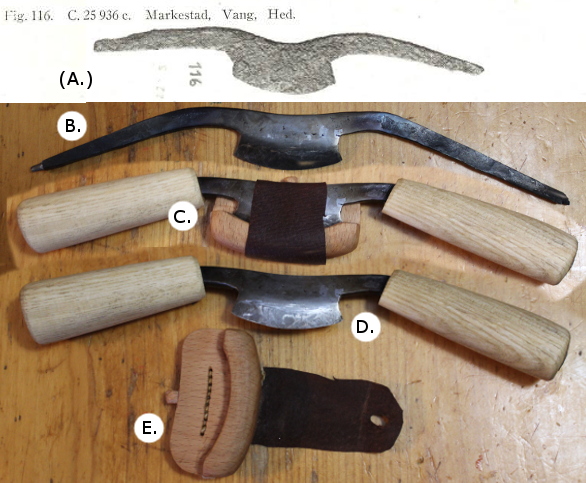
The spokeshave pictured (A.) was found in the Markland region of Norway and now resides in the Hedeby museum in Denmark. The next lower photo (B.) was taken after forging the reconstructed blade.
It is made of two grades of steel, with the inserted blade of better quality carbon steel, forge welded to the lesser grade steel forming the reins. The completed tool measures a little over 11" in length.
Photo (C.) shows the hackberry wooden handles which were driven onto the tangs, burned into predrilled holes. Also you will see the edge protection in place. Tools with fine edges are most always given special protection as sharpening and eventual replacement needed to be avoided at all times. Tools like these were ascribed for use by journeyman carpenter status only.
(D.) Here the blade is exposed for use and the "blade safe" (E.) is lying open. The safe is made of European beech and with a goat skin strap. The waxed linen threads lie in a groove below the surface to prevent the thread from being cut when placing the spokeshave back into its cover.
The photo illustration is a composite of stages of the same blade. The Spokeshave is delightfully sharp and a pleasure to use.

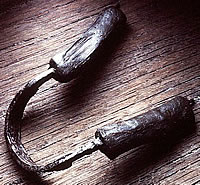
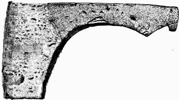
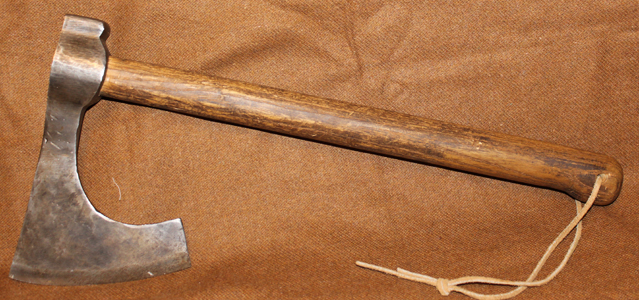 This axe, created by Albion Armory, was designed to look like the Mastermyr carpenters axe. An archeologist's rendering of the axe head can be seen to the right of this tool.
This axe, created by Albion Armory, was designed to look like the Mastermyr carpenters axe. An archeologist's rendering of the axe head can be seen to the right of this tool.The tool has a hammer head on the "pole" used for hammering nails and heading rivets. The sidewall's of the eye are thick to withstand heavy use. The handle design I chose to apply is a standard tool length with a bulb end, something common to European tools of later date. I do not have proof the handle was made this way during the Viking age but tool patterns were very well established at that time. This was my personal choice. I also included a thong on the end of the handle so if the shipwright uses the tool over water, he can slip his hand into the thong, preventing accidental loss. This too, is a workman's habit but not documented for the Viking age.
My tool kit should represent a similar collection owned by a craftsman who has experience as both a shipwright and general woodworker.
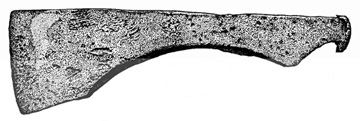
 This woodcutter's, builder's axe is made to emulate an axe from Professor Dan Carlson's Birka collection. The blade width is 4 1/2" and the handle is about 36" in length. Comfortable for felling trees and other large body work.
This woodcutter's, builder's axe is made to emulate an axe from Professor Dan Carlson's Birka collection. The blade width is 4 1/2" and the handle is about 36" in length. Comfortable for felling trees and other large body work.
As for the hand axe pictured in the insert and it's accompanying vignettes of some of the stages, the picture is proportional to the larger axe above. I forged this axe inspired by an axe from the Mastermyr tool kit (Pictured right) though many of this design have been found. The blade is narrow as it is a special purpose axe for finer or "close in" work. Again, the handle has a flared end to help the workman maintain a grip.
The blade on the smaller axe is 2" across the sharp and the head is 6" in length. As the pole (hammer head) has spreading damage from being struck and as the relative light weight of the axe, I suggest the tool was not swung but rather it was used like a chisel with a handle, perhaps for making mortises in timbers. Later morticing hatchets of similar design are known and available today from modern suppliers. It is worth mentioning, that although all these axes are intended as workman's axes, they do perform double duty when called on. The axe is clearly the weapon most associated with the Viking age.
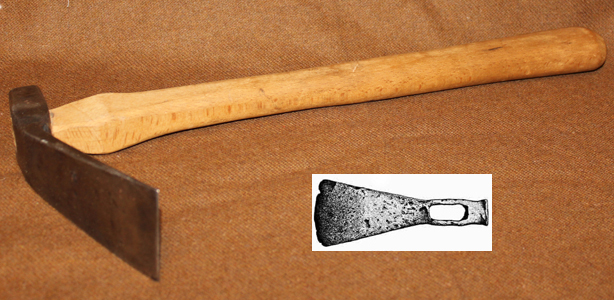 The adze, companion and cousin to the axe, with it's blade perpendicular to the handle, was the major tool for shaping and smoothing boards or removing large quantities of stock. This particular tool also has a hammer head. Oddly enough, though the carpenters plane was known as far back as the time of the Pharaohs and Roman age planes were found in Denmark, almost no planes or apparent blades found in the context of the Scandinavian culture until periods after. The one exception was a tool shaped like a broad spokeshave. To most historians the adze is seen as the primary smoothing tool for Vikings. Various studies of remaining tool marks on wood seems to support this. The absence of planes or their blades may be a quirk of the filter of time but modern carpenters wait for that certain clarifying find.
The adze, companion and cousin to the axe, with it's blade perpendicular to the handle, was the major tool for shaping and smoothing boards or removing large quantities of stock. This particular tool also has a hammer head. Oddly enough, though the carpenters plane was known as far back as the time of the Pharaohs and Roman age planes were found in Denmark, almost no planes or apparent blades found in the context of the Scandinavian culture until periods after. The one exception was a tool shaped like a broad spokeshave. To most historians the adze is seen as the primary smoothing tool for Vikings. Various studies of remaining tool marks on wood seems to support this. The absence of planes or their blades may be a quirk of the filter of time but modern carpenters wait for that certain clarifying find.
The insert drawing is of the Mastermyr toolbox adze.

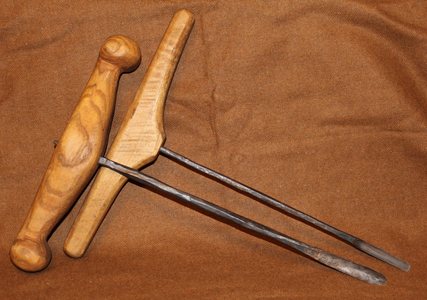 Drills, mounted on a "T" handle, were prolific during the Viking age. Examples of the iron bits have been found throughout the range of Scandinavian culture. Later illustrations have shown the same tool in use, though there are no pictures from the Viking age.
Drills, mounted on a "T" handle, were prolific during the Viking age. Examples of the iron bits have been found throughout the range of Scandinavian culture. Later illustrations have shown the same tool in use, though there are no pictures from the Viking age.
To the right are examples from the Mastermyr tool box. The kit had a full array of bits from small to large.
A story I have heard, is only the journeyman or master carpenter could use the drill, as there were so many man hours expended in making one board they wouldn't risk having a hole drilled in the wrong location.

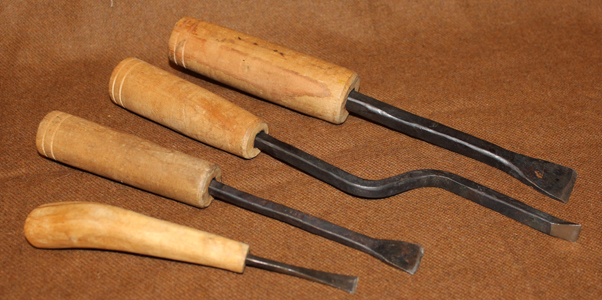 Chisels, common of all periods and prolific in finds, graces any tool kit. The top chisel is a close copy of the Mastermyr chisel pictured on the right. large and heavy, that one would be used for chopping out rough shapes.
Chisels, common of all periods and prolific in finds, graces any tool kit. The top chisel is a close copy of the Mastermyr chisel pictured on the right. large and heavy, that one would be used for chopping out rough shapes.
The second chisel below is a "router", made for lifting out wood from between two parallel cuts or scribed lines, thus creating a "rabbet" or groove.
The third is a smaller version of the top, then the lowest, smaller is a carving "fishtail" chisel. The handle is an apple wood branch with a natural curve, which fits nicely into the hand.

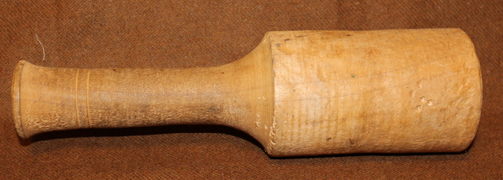 Needed for the chisels, a wooden mallet is the "hammer" of choice against wooden handles. Even today, a favorite of wood carvers, the rounded striking surface of the tool makes aiming a small matter. Note the three little dots on the head's upper face, I just wasn't quick enough to stop an enthused ten year old boy from using it to strike a steel tool... also a bad idea.
Needed for the chisels, a wooden mallet is the "hammer" of choice against wooden handles. Even today, a favorite of wood carvers, the rounded striking surface of the tool makes aiming a small matter. Note the three little dots on the head's upper face, I just wasn't quick enough to stop an enthused ten year old boy from using it to strike a steel tool... also a bad idea.
On the right is the inspiration for this mallet, found on the Oseberg ship burial from around 700AD. In the archeological record, this mallet is listed as being intended as a textile tool, for beating flax. Mallets had many uses.

 Of the few saws found from the Viking age, none were found that could have been used for sawing large slabs of wood or to be used as cross-cut saws. This might have something to do with the fact that the Viking age smiths did not have the technology to make large sheets of iron. The effort and skill of the smith/saw-wrights to have made such a thin and flat blade, made the tool rare and valuable. Boards were hand split off the log rather than sawn. This saw's blade is 14" in length.
Of the few saws found from the Viking age, none were found that could have been used for sawing large slabs of wood or to be used as cross-cut saws. This might have something to do with the fact that the Viking age smiths did not have the technology to make large sheets of iron. The effort and skill of the smith/saw-wrights to have made such a thin and flat blade, made the tool rare and valuable. Boards were hand split off the log rather than sawn. This saw's blade is 14" in length.
Above the saw, is the "saw safe" a simple case to keep to teeth from damage. Something as valuable and difficult to sharpen was kept from casual use and well protected.
 This small saw is designed to cut the teeth in bone combs. I did not have a documented original but what I did want was a saw that was designed for small work, a narrow blade and what is most important, the teeth of the saw are NOT set. Saws, going back to the time of the pyramids, have been made to have each tooth "set" so each tooth points, left, right,left, right, etc. But examination of extant find of combs, the bottom of the saw curf is V shaped. If the saw teeth had set, the bottom of the cut would have a W shape.
This small saw is designed to cut the teeth in bone combs. I did not have a documented original but what I did want was a saw that was designed for small work, a narrow blade and what is most important, the teeth of the saw are NOT set. Saws, going back to the time of the pyramids, have been made to have each tooth "set" so each tooth points, left, right,left, right, etc. But examination of extant find of combs, the bottom of the saw curf is V shaped. If the saw teeth had set, the bottom of the cut would have a W shape.
The blade length of my comb-tooth saw is 3 1/2" long. The handle is from a local ash branch.
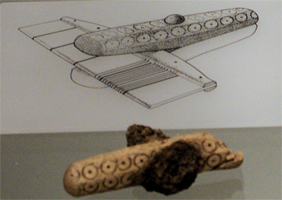


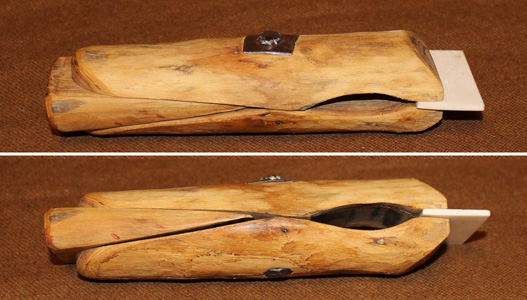 This hand vise was needed for delicate hand work. Used for working anything from bone, wood or metal, crafter of all trades kept versions of this vise in their collection. One iron pin, peened over a square washer holds the two jaws at the fulcrum point, while a wedge tightens the jaws onto any sized work piece.
This hand vise was needed for delicate hand work. Used for working anything from bone, wood or metal, crafter of all trades kept versions of this vise in their collection. One iron pin, peened over a square washer holds the two jaws at the fulcrum point, while a wedge tightens the jaws onto any sized work piece.
I have pictured the vise gripping a shaped piece of bone which will eventually become a new comb, to illustrate the vise's usefulness.
On the right are two museum pieces and the B&W photo is of a hand vise recovered from an excavation in the Viking ship building community of Hedeby, Denmark. (Now part of northern Germany.) You might notice, the photographer has his tool reversed and the working end is shown sans comb. The first, smaller photo, has the wedge placed in the correct position. Remember, this tool is still found in even the most skilled of crafter's and jewelers tool kits today. The tool's total length is 7" long.
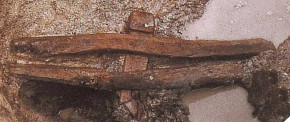
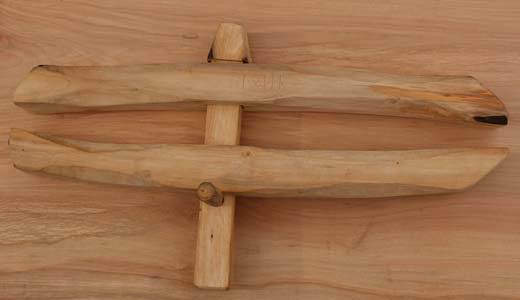 The first clamp to the left is intended to assist in boat building, clamping the wide boards where they overlap. This clamp has a reach, twelve inches deep. The jaws are made of ash branches, utilizing the natural curve. A wedge or two would be driven into the far left end of the clamp, to tighten it on the intended spot needing clamping. For building a boat, the carpenter would employ many of these, similar in size or bigger, as the needs dictate. The tools total length is 22" long.
The first clamp to the left is intended to assist in boat building, clamping the wide boards where they overlap. This clamp has a reach, twelve inches deep. The jaws are made of ash branches, utilizing the natural curve. A wedge or two would be driven into the far left end of the clamp, to tighten it on the intended spot needing clamping. For building a boat, the carpenter would employ many of these, similar in size or bigger, as the needs dictate. The tools total length is 22" long. 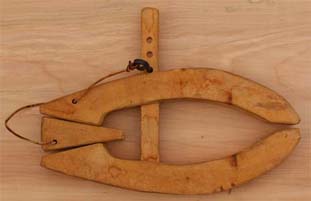
This second clamp is smaller but based on the same principle. Made of curved branches takes advantage of the natural strengths. This smaller clamp can be adjusted for a bigger variety of uses, though the reach of the jaws is about seven inches deep. The tool is made of maple and its total length is 14" long.
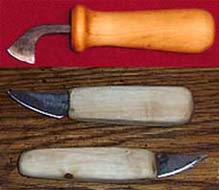 Though these knives do not have a specific museum artifact original as their inspiration, close in tools are always needed by a crafter. The first knife works well for cutting leather or sheet goods, while the second two are simple cutting and carving knives.
Though these knives do not have a specific museum artifact original as their inspiration, close in tools are always needed by a crafter. The first knife works well for cutting leather or sheet goods, while the second two are simple cutting and carving knives.